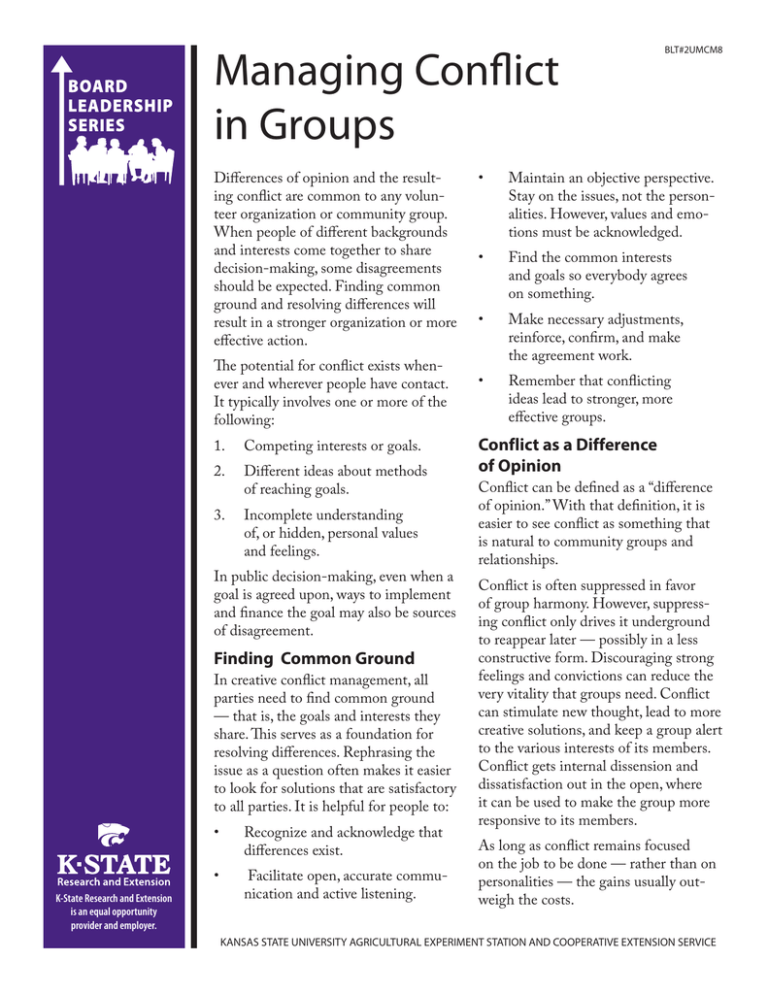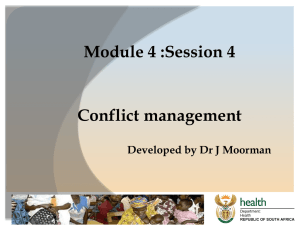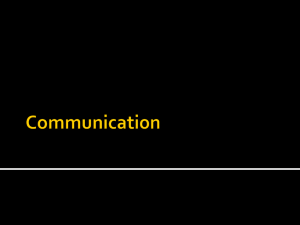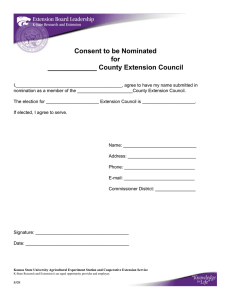Managing Conflict in Groups
advertisement

Managing Conflict in Groups Differences of opinion and the resulting conflict are common to any volunteer organization or community group. When people of different backgrounds and interests come together to share decision-making, some disagreements should be expected. Finding common ground and resolving differences will result in a stronger organization or more effective action. The potential for conflict exists whenever and wherever people have contact. It typically involves one or more of the following: 1. Competing interests or goals. 2. Different ideas about methods of reaching goals. 3. Incomplete understanding of, or hidden, personal values and feelings. In public decision-making, even when a goal is agreed upon, ways to implement and finance the goal may also be sources of disagreement. Finding Common Ground In creative conflict management, all parties need to find common ground — that is, the goals and interests they share. This serves as a foundation for resolving differences. Rephrasing the issue as a question often makes it easier to look for solutions that are satisfactory to all parties. It is helpful for people to: • • K-State Research and Extension is an equal opportunity provider and employer. Recognize and acknowledge that differences exist. Facilitate open, accurate communication and active listening. • • • • BLT#2UMCM8 Maintain an objective perspective. Stay on the issues, not the personalities. However, values and emotions must be acknowledged. Find the common interests and goals so everybody agrees on something. Make necessary adjustments, reinforce, confirm, and make the agreement work. Remember that conflicting ideas lead to stronger, more effective groups. Conflict as a Difference of Opinion Conflict can be defined as a “difference of opinion.” With that definition, it is easier to see conflict as something that is natural to community groups and relationships. Conflict is often suppressed in favor of group harmony. However, suppressing conflict only drives it underground to reappear later — possibly in a less constructive form. Discouraging strong feelings and convictions can reduce the very vitality that groups need. Conflict can stimulate new thought, lead to more creative solutions, and keep a group alert to the various interests of its members. Conflict gets internal dissension and dissatisfaction out in the open, where it can be used to make the group more responsive to its members. As long as conflict remains focused on the job to be done — rather than on personalities — the gains usually outweigh the costs. KANSAS STATE UNIVERSITY AGRICULTURAL EXPERIMENT STATION AND COOPERATIVE EXTENSION SERVICE Why Does Conflict Occur? Some conflict is inevitable in human relationships. Often clashes occur over perceived differences rather than real ones. People anticipate blocks to achieving their goals that may or may not be there. • Conflict often results from: • • • • A lack of communication. Failing to share ideas and feelings allows others to fill in the gaps. Members of the group might “read in” what the other person or persons will say, or anticipate their responses. It can create suspicions that provoke anxiety — and lead to looking for the worst. If this continues, trust becomes lower, and group members may become suspicious and defensive. A value conflict in which two people have different attitudes, beliefs, and expectations. These differences may interfere in making decisions when group members are inflexible and hold rigid beliefs about the “right way” to do things. People choose different goals or methods to achieve the same goals because they hold different values or beliefs. Since each goal requires an investment of time, effort, and some sacrifice, it may not be possible to pursue one goal without sacrificing the other to some extent. A lack of effective leadership or decision-making. Lack of agreement about who is in charge or how the group will function can be a source of conflict. For example, if one person in a group expects democratic decision-making (all members have input) and others expect someone to make assignments (designated leader), the group may have difficulty resolving differences of opinion. When differences exist, members can become sidetracked in a hassle over who will decide, whose opinion is going to be accepted as the “right” one, or what the decision-making process should be. The resulting conflict can become a win-lose struggle. Discrepancies in role expectations. Difficulties can arise if people see their own and each others’ roles differently. For example, if the officers see their role as running the organization, and the members see themselves as not only contributing • • information and opinions, but also having a real voice in decisions, conflict may arise. Low productivity. Being able to accomplish tasks and achieve goals is essential in the organizational environment. If a task is not done, the chairperson may become angry. If the person assigned that task finally responds by performing the task, a response pattern of anger to get results can be established. Groups with low productivity may use nagging, making trade-offs (I’ll do this if you do that), and criticizing, but these tend to produce only short-term success. Change that causes disequilibrium. While change is considered to be a “given” for people working and living together, another “given” is that people tend to prefer secure, predictable responses to the unknown. When changes occur abruptly and unpredictably, conflict may follow. Unresolved prior conflict. As the number of past unresolved conflicts increases, so does the possibility of future ones. People sometimes shy away from conflict management because memories of past conflicts still hurt. Probably the most lasting of those “scars” have been caused by conflicts with those who are closest — family, close friends, and trusted colleagues among volunteer or work groups. The Conflict Cycle Conflict tends to follow a cycle, as represented in the following diagram. Tension Development Role Dilemma Adjustment Confrontation Injustice Collecting KANSAS STATE UNIVERSITY AGRICULTURAL EXPERIMENT STATION AND COOPERATIVE EXTENSION SERVICE Tension Development: As a disagreement or threat begins to develop, the various parties start taking sides. The conflict can appear immediately or keep building over time. Role Dilemma: People or groups who are involved raise questions about what is happening, who is right, or what should be done. They try to decide whether they should take sides and, if so, which one. Tension Development and Role Dilemma often occur at the same time. Injustice Collecting: Each party begins to gather support. Each itemizes the problems, justifies its position, and thinks of ways to win. Confrontation: The parties meet and clash. If both parties hold fast to their opinions, barriers may develop. Confrontation may be lessened or avoided if one or both parties make adjustments. Adjustments: If one party is weak and the other strong, the strong party might win by sheer domination — but the conflict may reappear. If parties have equal power, and neither party decides to change, they can wage a “cold war,” each trying to weaken the other. One party may choose to avoid the other. The parties may choose to compromise, each gaining a little and losing a little. The two parties can work together, actively looking for a solution that takes care of both parties’ needs. In most organizations and communities, only compromise or working together resolves the conflict over time. Compromise in this context means giving up some less important factors — not giving up one’s principles. Other adjustments are, at best, short-term solutions, and the conflict will reappear. Dealing with Conflict Individuals and groups may use several different methods of dealing with controversy. Some methods focus on preserving the relationship and resolving the issue, while others tend to have negative results. or leave the situation (for example, quit a job, leave school, get divorced). Either they cannot face such situations effectively, or they do not have the skills to negotiate them. Avoidance strategies generally are not satisfying. They tend to leave doubts and fears about meeting the same type of situation in the future. Diffusion Diffusion strategies are delaying actions in an attempt to cool the situation, at least temporarily. Examples include: resolving minor points while delaying discussion of the major problem, postponing a confrontation until a more appropriate time, and avoiding clarification of the issues underlying the conflict. Similar to avoidance strategies, these tactics typically result in feelings of dissatisfaction, anxiety about the future, and concerns about oneself. Confrontation The third major strategy involves an actual confrontation of conflicting issues or persons. Confrontation can be divided into win/lose (power) strategies and win/win strategies. Power strategies include the use of physical force (a punch in the nose, war), bribery (money or favors), or punishment (withholding love or monetary support). Such tactics are often successful from the winners’ point of view: They win, and the others lose. A closer look at the power struggle suggests that it is probably not that simple. All win/lose strategies suffer from the conflict trap: In her or his own mind, the loser may feel justified for reversing the situation the next time. As a result, win/lose strategies ­— particularly the power strategy — are as much conflict generators as conflict resolvers. The feelings of the loser are the seeds from which the next round of conflict will likely grow. Arbitration Arbitration is often the result of a fight strategy. When both sides in the fight are equally powerful and have equal rights, a stalemate occurs, and a third party may be asked to decide the issue. The problem with this strategy is that when the third party or judge decides between the conflicting parties, Some people attempt to avoid conflict situations the loser seldom feels that justice has been done. The altogether or to avoid certain types of conflict. They issue has been decided, but the hostility carries over tend to repress emotional reactions, look the other way, and becomes a cause for renewed conflict. Avoidance KANSAS STATE UNIVERSITY AGRICULTURAL EXPERIMENT STATION AND COOPERATIVE EXTENSION SERVICE Voting Voting is a civilized form of fighting. A vote, rather than an open fight, is possible when the following conditions are present: 1. Participants in a conflict could be persuaded to change positions on the issue if they are convinced to do so (election campaign). 2. Beliefs and commitments to principles or to an organization hold the parties together in a continuing relationship (democracy). 3. Participants will generally abide by the preference of the majority. Conflict Management Process In any group situation, a struggle might occur over guidelines or rules — who sets them, what rules exist, and what happens when rules are broken. The following are suggested guidelines that all parties must agree to for the creative conflict management process to proceed. If the parties don’t agree, the process will quickly deteriorate as people try to win as much and lose as little as possible. • Compromise Compromise strategies use negotiation and bargaining to reach a satisfactory agreement. The premise behind compromise is that partial victory is better than winning nothing at all. Ideally, in a compromise each side gives up something of lesser value to achieve or retain a greater goal. Compromise in this context is a form of negotiation. It does not involve giving up one’s principles or values. Compromise, at its best, turns into consensus — a win-win result. • • Consensus Consensus seeks to bring all parties in the conflict to a mutually satisfying resolution of the issue. Consensus is possible in an atmosphere in which better answers and solutions are likely to emerge from differences. This is often called problem-solving and is based on common interests. Synergy Synergy is the highest form of conflict resolution. Imagine a ping-pong game in which your objective is, as a player, to return the ball in a way to maximize the probability that your opponent will hit the increasingly difficult shots. This reverses the win/lose strategy. The competition is invigorating when it is used to increase mutual wins. The better each party plays, the more both win ... and the more both enjoy it. Synergistic thinking encourages using the mind, resources, and values of others to enlarge the amount of winnings. Unlike power confrontations, both sides can win. The aim of these strategies is to resolve the conflict with a solution that is mutually satisfying to each of the parties involved. • • • Agree that now is a good time to attempt to resolve the conflict. Allow “prime time” when energy is high and motivation is positive, not when the parties are angry, tired, or trying to meet a deadline to adjourn. Share the common goal with everyone involved. The goal of creative conflict is deeper understanding, not “I win, you lose.” Review the ground rules for maintaining trust and respect for others. See if the group wishes to add any others. The group, as well as the facilitator, has a responsibility to see that discussion focuses on the issue and that people listen to one another. Discuss the specific issue or specific behavior, not the person, personality, or motivation. However, emotions should be discussed. Focus on the present. Avoid engaging in faultfinding from the past. Agree on which sources of information will be used. Provide face-saving mechanisms. Don’t corner the other person. Allow a “time out” if emotion becomes too heavy, and then set a time to resume. Sometimes you have to agree to disagree. At other times, it’s useful to designate a trial period to see how something works out. After everyone has agreed on guidelines about resolving a conflict, develop suggestions for negotiation that consider both the relationship and the issue at stake. Recognize that personal, emotional issues may be involved. The facilitator’s job is to keep both the conflict itself and the processes of conflict resolution from including personal blame or offensive language. It helps to break down a big issue into smaller parts. Increasing the number of points that can be discussed separately offers more scope for negotiation and trade-offs. Bring in factual evidence wherever possible. Skilled negotiators try to reframe issues and provide different ways to look at the conflicting positions. They focus on interests rather than on single proposed solutions. Third-Party Mediation To resolve a conflict, two conditions must be met: 1. A cooperative rapport must be established between the conflicting parties, with a genuine concern for each other’s needs. 2. The parties must find a solution acceptable to both sides. Not all conflicts can be successfully resolved at a Conflict resolution can often be assisted by a thirdparticular time. A willingness to develop a cooperative party mediator. From time to time, each of us will have spirit and to engage in joint problem-solving, along the opportunity to serve as a mediator to help others with some specific strategies are often successful. This work out differences. is often called interest based negotiation. To be helpful, the mediator must remain neutral. The role of mediator is similar to that of a traffic cop, with Improving Conflict Management Skills the main responsibility to direct traffic — not promote Much conflict in groups stems from “communication gaps.” For the effective management and perhaps a given solution or solve the problem for the other ultimate resolution of conflict, two skills are necessary parties. The mediator suggests different approaches to — active listening and the clear sharing of concerns resolving conflict, ensures an open and balanced conthrough “I-Messages.” versation flow, enforces ground rules, and protects the involved individuals from personal attack. Listening is the area that most often falls short in efforts to manage conflict. Really listening to conConflict Resolution flicting needs, wants, concerns, fears — and the feelThe distinction between conflict management and ings behind them — allows for better understanding. conflict resolution is important. We can manage Rather than listening, it’s common to question, conconflict by withdrawing, by attacking or overpowerfront, defend, and use power or influence to overwhelm ing the other person, or by working out a compromise, the opposition. Instead of hearing and understanding but these strategies will not resolve the conflict. Each the other person’s view, we focus on getting our points of these strategies carries a certain cost to the relaacross. We try to convince the other person of how tionship. Also, since the conflict is only managed, not right we are. Thought we might bring rational, logical resolved, it is likely to resurface. ideas to bear, results are limited. Results of Conflict Resolution Successful • Better ideas are produced. • People are forced to search for new approaches. • Unsuccessful • People feel defeated and humiliated • Longstanding problems surface and are addressed. The distance between the parties increases instead of decreasing. • A climate of distrust develops. • People are forced to clarify their views. • Cooperation may decrease. • Tension stimulates interest and creativity. • • People have a chance to test their capabilities. Resistance develops when teamwork is needed. KANSAS STATE UNIVERSITY AGRICULTURAL EXPERIMENT STATION AND COOPERATIVE EXTENSION SERVICE Listen. To manage conflict effectively, we first have to listen. We must: • Stop talking. • Be attentive. Assume an open posture and make regular eye contact. Physically react: nod, smile, or take notes. Clearly show that you are listening. • • • • • • Give the person total attention. If you are thinking about what to say next, you are not listening Open the door. Ask the person to share thoughts, feelings, or frustrations. Use phrases such as “Tell me about it,” “Go on,” or “Good point.” Reflect. Summarize back to the person what was said. “You feel ...” or “You are concerned with ...” Reflect the feelings as well as the words spoken: “You were quite annoyed over . . .” Reflective listening clearly indicates a developing rapport and enhanced communication. Probe. Ask for more information: “Please explain what you mean by . . .” Don’t interrogate but try to clarify. Show genuine interest. Until people feel listened to, understood, and respected in their views, they will not be open to considering different views. Use “I-Messages.” Active listening is key to effective conflict management, but will not resolve the conflict alone. You must also clearly convey your opinion, needs, concerns, and feelings to try to gain the other party’s understanding and respect. Only then can collaborative problem-solving begin. The “I-message” provides an effective means to express thoughts in an assertive but nonthreatening manner. It involves expressing the concern, needs, opinion, or feeling through an honest, straightforward statement that begins with the word “I” — “I’m concerned about . . . ,” “I would prefer if we . . . ,” “I was embarrassed by . . . ,“ “I suggest . . . ,” Take care to express yourself in a direct but nonthreatening, nonjudgmental manner. Much conflict can be resolved through a simple process of shifting back and forth between active listening and “I-messages.” This allows for clarification and understanding of each other’s needs and concerns as well as the feelings behind them. As you begin to better understand each other’s points of view, you move on to collaborative problem solving — to the resolution of the conflict. The key is willingness to be involved in the process of listening and sharing clear “I-messages.” (See next page for techniques.) Summary Conflict can be managed by withdrawing, by attacking, by overpowering the others involved, or by reaching a compromise. But these do not resolve the conflict, and it is likely to resurface. To truly resolve the conflict a cooperative rapport must be established between the conflicting groups, with a concern for each other, and a solution must be found that is acceptable to both sides. References 1. Dunn, Douglas. Community Leadership and Resource Development. Arizona Cooperative Extension, Tucson, 1986. 2. Robinson, Jerry Jr., Roy A. Clifford, and Carol Louise Moorhead. Management In Community Groups. University of Illinois at Urbana–Champaign,1974. 3. Griffin, Charlie. Creating a Win–Win Environment in the Workplace. Presented at: Kansas State University’s Annual Extension Conference Workshop. Manhattan, 1989. 4. Lindgren, Herb. Managing Conflict Successfully. Presented at: University of Nebraska Cooperative Extension Service Workshop. Lincoln, 1990. 5. Fisher, Roger and William Ury. Getting to Yes: Negotiating Agreement Without Giving In, 2nd ed. Bruce Patton, editor. New York: Penguin Books USA, Inc., 1991. 6. Pfeiffer, J. W. and L. D. Goodstein. The 1982 Manual for Facilitators, Trainers, and Consultants. University Assn., Inc., 1982. 7. Walker, James L. and Lilly J. Walker. The Human Harvest, Changing Farm Stress to Family Success. Brandon, Manitoba, Canada: Brandon University, 1987. KANSAS STATE UNIVERSITY AGRICULTURAL EXPERIMENT STATION AND COOPERATIVE EXTENSION SERVICE Techniques to Remember 1. Initiate an open discussion about the conflict. 2. Be assertive and not aggressive. State your position in a nonthreatening way. 3. Communicate the idea that — even though you disagree — you respect the other party. (This is similar to the concept of telling your child that — even though you dislike bad behavior — you still love the child.) 4. Affirm your positive feelings for the other party to try to open the door to more acceptance. 5. Don’t be reluctant to consider compromise. Meet halfway. 6. Suggest considering a compromise. Find a common ground of agreement. Use it to help resolve the conflict. 9. Constructive conflict resolution begins with your actions, feelings, skills, and willingness to change. 10. Outline a plan of action to resolve the conflict. What will you do to try to resolve it? How do you expect the other party to respond? What will you do if the response is different than you expected? 11. Keep conflict resolution efforts constructive. Gently challenge views, but never threaten. 12. Begin conflict resolution efforts by working together to build a climate of trust. Cooperative interaction has a powerful positive effect on the relationship. 7. Consider humor to help defuse the tension. 13. Refrain from labeling the other party’s position. Labeling ideas as “wrong,” “simplistic,” or “ridiculous,” elicits an equally negative reaction and a defensive stance. 8. Every argument seems to have at least two “innocent victims,” each suffering a “wrong” from the other. Examine your own behavior. Are you being unreasonable or inflexible? 14. Avoid “no-win” situations that can damage a relationship. Is the issue that created the conflict really worth the cost of the grief it could be causing? KANSAS STATE UNIVERSITY AGRICULTURAL EXPERIMENT STATION AND COOPERATIVE EXTENSION SERVICE K-State Research and Extension is an equal opportunity provider and employer. Issued in furtherance of Cooperative Extension Work, Acts of May 8 and June 30, 1914, as amended. Kansas State University, County Extension Councils, Extension Districts, and United States Department of Agriculture Cooperating, John D. Floros, Director.


